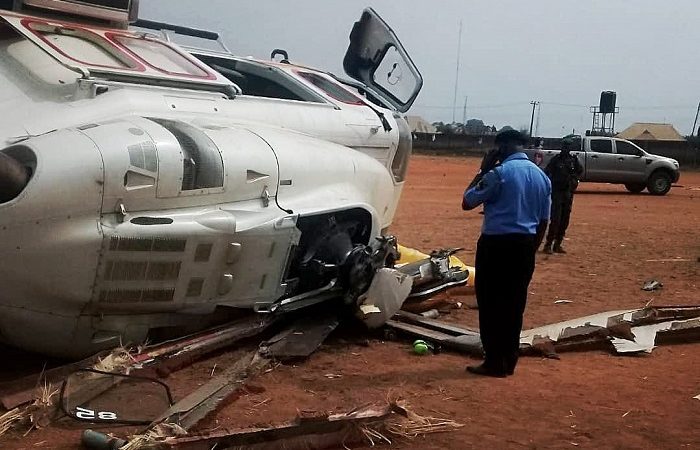Bureau Blames Pilot For Crashing Osinbajo’s Chopper

The Accident Investigation Bureau (AIB) has released the final report on the helicopter crash involving Vice President Yemi Osinbajo, which occurred at Kabba, Kogi State in February 2019, blaming the incident on a misjudgment of distance by the crew members, inappropriate landing techniques and non-adherence to the landing process.
The Agusta Westland 139 chopper with registration number 5N-CML, owned and operated by Caverton Helicopters Limited, crash-landed at Kabba Stadium.
The chopper had on board Osinbajo and 11 others, including the crew members.
Osinbajo was scheduled to launch the distribution of Traders’ Money to market women in Kogi State.
AIB Commissioner/Chief Executive Officer (CEO), Mr. Akin Olateru, released the report yesterday, with three others involving Aero Contractors and Ilorin International Aviation College.
He noted that the helicopter crew had initially sighted the football field before losing visual contact with the ground and the external surrounding.
According to him, at exactly 1:43 pm, the helicopter experienced a hard landing on the right main landing gear and rolled over.
All the occupants were evacuated unhurt.
Listing the causal factors, Olateru blamed the incident on a misjudgment of distance by the crew members, inappropriate landing techniques and non-adherence to the landing process.
He also said the helicopter operator failed to conduct a risk assessment of the landing preparedness.
The bureau faulted the crew for inappropriate landing techniques and limited planning before the commencement of the flight.
Giving details of what led to the crash in Kabba, Olateru said: “At about 13:46hrs, the helicopter departed Abuja runway 22 for Kabba.
Onboard were 12 persons, including the Vice President of the Federal Republic of Nigeria, his entourage, and three crew members (pilot, co-pilot, and an engineer).
The flight crew stated that they sighted the intended landing area as a result of the cloud of residual dust generated by the downwash of a police helicopter.
After sighting the football field, the flight crew approached with the speed of 20ft to about a 100ft and entered a hover to land.
At about 50ft above ground level, a brownout set in. The flight crew lost visual contact with the ground and external surroundings.
The co-pilot began radio altitude callouts
35, 30, 25, 20 and 15”. At about 14:34h, the helicopter experienced a hard landing on the right main landing gear and rolled over onto its right side. All persons on board were evacuated uninjured.
The flight crew encountered a brownout condition during the hover to land, which led to the loss of external visual references, spatial disorientation, and loss of situational awareness resulting in a misjudgment of distance and ground clearance, as the flight, the crew tried to control the helicopter’s movements for landing. The helicopter landed hard and rolled over on its right side.
On other factors that may have led to the crash, he said:
Inappropriate landing technique used, non-adherence to company procedures for known or anticipated brownout condition during landing and lack of risk assessment, limited landing site preparation, and planning prior to commencement of the flight.
However, the commissioner said 11 days after the crash, the bureau issued two interim safety recommendations in its interim report to the Nigeria Civil Aviation Authority (NCAA) and Caverton.
The other three reports were two incidents involving Ilorin Aviation College at the Ilorin International Airport and Aero Contractor Port Harcourt- Lagos flight, which experienced smoke on board.

Justin Nwosu is the founder and publisher of Flavision. His core interest is in writing unbiased news about Nigeria in particular and Africa in general. He’s a strong adherent of investigative journalism, with a bent on exposing corruption, abuse of power and societal ills.













